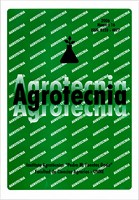Propagación vegetativa de Petiveria alliacea L. var. alliacea
DOI:
https://doi.org/10.30972/agr.0336898Palabras clave:
Estacas, proliferación, sustrato, regulador de crecimientoResumen
El objetivo del presente trabajo fue evaluar la multiplicación de Petiveria alliacea L. var. alliacea mediante estacas en las condiciones agroecológicas del noroeste de la Provincia de Corrientes determinando su época de propagación más adecuada, sustrato más adecuado y el uso de promotores de enraizamiento. Fueron analizados los factores: tipo de estaca (niveles: estacas terminales y estacas intermedias), tipo de sustrato (niveles: arena y mezcla comercial) y tratamiento con regulador de crecimiento vegetal (niveles: con y sin). El ensayo fue repetido en otoño, invierno y primavera. Una vez obtenidos los resultados de cada ensayo se procedió a realizar su correspondiente análisis de la variancia previa verificación de la normalidad y test de significancia (Test de Tukey a un nivel = 0.05) empleándose el software Infostat. El análisis estadístico se realizó para cada fecha de estaqueo, y se evaluaron los factores principales por separado, así como las posibles interacciones. Se concluyó que la multiplicación por estacas es un método rápido y eficiente de propagación asexual de Petiveria alliacea L. var. alliacea. Las estacas intermedias fueron las más convenientes para obtener éxito en el enraizamiento y posterior brotación. El tratamiento de las estacas con ANA no sería necesario mientras el estaqueo se realice en primavera y otoño, pero sí sería conveniente cuando se desee propagar esta especie mediante estacas en invierno. El sustrato arena fue donde se obtuvieron los mayores porcentajes de enraizamiento y brotación.



